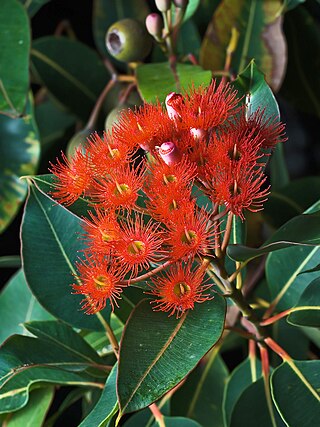
Corymbia ficifolia, commonly known as red flowering gum, is a species of small tree that is endemic to the south-west of Western Australia. It has rough, fibrous bark on the trunk and branches, egg-shaped to broadly lance-shape adult leaves, flower buds in groups of seven, bright red, pink or orange flowers and urn-shaped fruit. It has a restricted distribution in the wild but is one of the most commonly planted ornamental eucalypts.
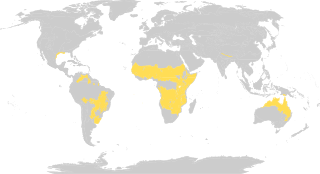
Tropical and subtropical grasslands, savannas, and shrublands is a terrestrial biome defined by the World Wide Fund for Nature. The biome is dominated by grass and/or shrubs located in semi-arid to semi-humid climate regions of subtropical and tropical latitudes. Tropical grasslands are mainly found between 5 degrees and 15 degrees North and south of the Equator.

Juniperus ashei is a drought-tolerant evergreen tree, native from northeastern Mexico and the south-central United States to southern Missouri. The largest areas are in central Texas, where extensive stands occur. Ashe juniper grows up to 10 metres tall, and over time can reach 15 m (49 ft), and provides erosion control and year-round shade for wildlife and livestock.
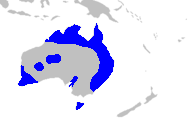
Xanthorrhoea is a genus of about 30 species of flowering plants endemic to Australia. Species are known by the name grass tree.
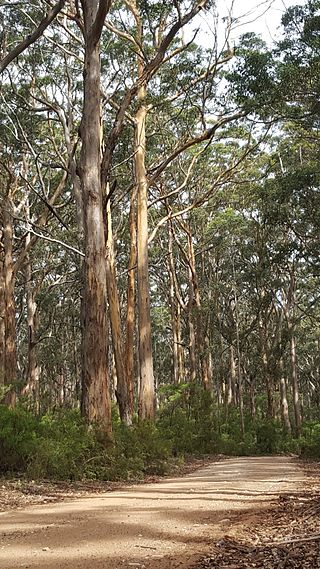
Eucalyptus diversicolor, commonly known as karri, is a species of flowering plant in the family Myrtaceae and is endemic to the south-west of Western Australia. It is a tall tree with smooth light grey to cream-coloured, often mottled bark, lance-shaped adult leaves and barrel-shaped fruit. Found in higher rainfall areas, karri is commercially important for its timber.

Baron Sir Ferdinand Jacob Heinrich von Mueller, was a German-Australian physician, geographer, and most notably, a botanist. He was appointed government botanist for the then colony of Victoria (Australia) by Governor Charles La Trobe in 1853, and later director of the Royal Botanic Gardens, Melbourne. He also founded the National Herbarium of Victoria. He named many Australian plants.
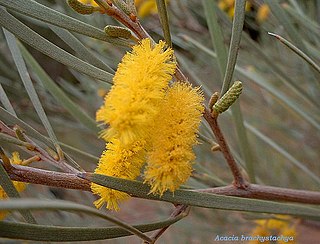
Acacia brachystachya, commonly known as umbrella mulga, turpentine mulga or false bowgada, is a shrub in the family Fabaceae. The species occurs in mulga and heath communities on sandhills and rocky ridges in all mainland states of Australia, except Victoria.

Agrostis stolonifera is a perennial grass species in the family Poaceae.
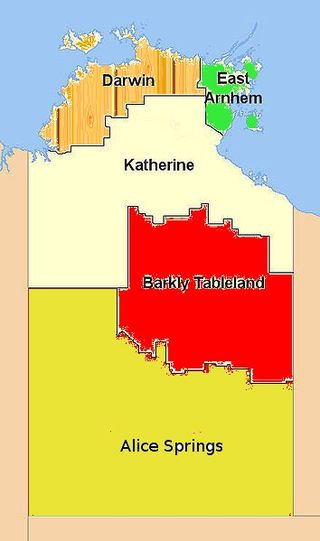
The Barkly Tableland is a rolling plain of grassland in Australia. It runs from the eastern part of the Northern Territory into western Queensland. It is one of the five regions in the Northern Territory and covers 283,648 square kilometres (109,517 sq mi), 21% of the Northern Territory. The Barkly Tableland runs parallel to the southern shore of the Gulf of Carpentaria, from about Mount Isa, Queensland to near Daly Waters.

Kunzea pomifera, commonly known as muntries, emu apples, native cranberries, munthari, muntaberry or monterry, is a low-growing or prostrate shrub with hairy stems, small, mostly egg-shaped leaves, groups of white flowers on the ends of the branches and fleshy, more or less spherical, edible fruit.
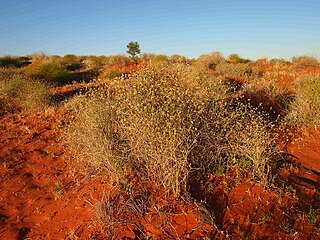
Zygochloa is a genus of desert plants in the grass family known only from Australia. The only known species is Zygochloa paradoxa, commonly known as sandhill canegrass. It occurs in extremely arid areas such as the Simpson Desert.

Brachychiton rupestris, commonly known as the narrow-leaved bottle tree or Queensland bottle tree, is a tree in the family Malvaceae native to Queensland, Australia. Described by Sir Thomas Mitchell and John Lindley in 1848, it gained its name from its bulbous trunk, which can be up to 3.5 metres (11 ft) diameter at breast height (DBH). Reaching 10–25 metres (33–82 ft) high, the Queensland bottle tree is deciduous, losing its leaves between September and December. The leaves are simple or divided, with one or more narrow leaf blades up to 11 centimetres (4 in) long and 2 centimetres (0.8 in) wide. Cream-coloured flowers appear from September to November, and are followed by woody boat-shaped follicles that ripen from November to May. No subspecies are recognised.

Papillilabium beckleri, commonly known as the imp orchid, is the only species in the genus Papillilabium from the orchid family, Orchidaceae. It is a small, epiphytic orchid with many thin roots, between two and six linear leaves and up to eight pale green or brownish flowers. The flowers are fragrant, produce nectar and have a warty labellum. It grows on shrubs and trees in humid places and near streams and is found between south-east Queensland and the Sydney region in New South Wales.

Peristeranthus hillii, commonly known as the beetle orchid or brown fairy-chain orchid is the only species in the genus Peristeranthus from the orchid family, Orchidaceae. It is an epiphytic or lithophytic orchid with more or less pendulous stems, between three and ten widely spaced, leathery leaves and a large number of pale green, often spotted flowers. It mainly grows on tree trunks and thick vines in rainforest and is found between the Bloomfield River in Queensland and Port Macquarie in New South Wales.

Panicum effusum, commonly known as hairy panic, is a grass native to inland Australia. It occurs in every mainland state, as well as New Guinea. In dry conditions, the fast-growing grass can become a tumbleweed.

The Victoria Plains tropical savanna is a tropical and subtropical grasslands, savannas, and shrublands ecoregion in northwestern Australia.

Acacia peuce, commonly known as Birdsville wattle, waddy, waddi, or waddy-wood, is a tree species that is endemic to central Australia. The Arunda peoples know the tree as Aratara, the Pitta Pitta know it as Kurriyapiri and Red Ochre Father while the lower Arrernte know it as Arripar.
Glycocystis beckeri is the only species of the flowering plant genus Glycocystis in the family Scrophulariaceae and is endemic to the south west of Western Australia. It is a shrub, similar to others in the genera Eremophila and Myoporum but is unusual in that it produces very large amounts of sticky, sweet-smelling resin produced by raised glands which cover the entire plant, except for the petals. It has been suggested that the resin traps insects which the plant uses as a source of nitrogen.

Eucalyptus odontocarpa, commonly known as Sturt Creek mallee, is a mallee that is native to northern Australia. Indigenous Australians know the plant as Warilyu.

Astrebla lappacea, commonly known as curly Mitchell grass, is a herb of the family Poaceae from the order Poales. The most common of the Astrebla species, a widespread Australian inland plant. Named in honour of Thomas Mitchell. Often seen on floodplains and heavy self mulching clay soils, growing to 0.9 metres tall. Flowering is in response to rain or flooding. This grass is palatable to livestock, even when dry. The Latin specific epithet of lappacea is derived from lappa meaning with burrs.


















